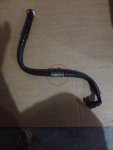Most fuel pressure gauges have a relief valve with a piece of tubing attached. Use the relief to measure fuel flow over a fixed time period. Collect the fuel pumped, and measure the quantity. Do some arithmetic.
If you can get a half-cup of fuel in 10 seconds, that's 3 cups per minute.... .75 of a quart per minute. More math says if you get 25mpg at 60, you need to pump 1/25 of a gallon per minute. (mile a minute)
I have an EFI 85 and have the factory 'canister' fuel filter mounted on the frame rail. Tried to replace it once, but the strap wrench would not budge the canister. Decided that if I crushed the canister, I'd never find a replacement ... and then what? Have a new filter element on the shelf.
The high pressure pump seems low on pressure. If the vacuum line is disconnected, or the pressure measured with the engine off, it should be higher. The VOLUME, or 'filter' won't make a difference as long as the pipes are full of fuel. It is NOT flowing any fuel when it pressurizes, so if it seeped into the rail, via the lift pump(through the sock) through the can filter, through the hi-pressure pump, at slow volume, it would not matter. Pressure is pressure, and volume is volume. It can show good pressure, but not flow ... then the filters come into question. But not at zero-consumption testing.
However, if the injectors are leaky, the pressure may be low, but it would run like mumble, too rich. Check the pressure, and leave the gauge attached for a minute or so. It should hold pressure for at least a few minutes. If it drops immediately, the check valve in the pump(s?) is be not working, or the injectors leak. It has a return line that I believe has a check valve back at the in-tank pickup which should hold pressure.
tom













